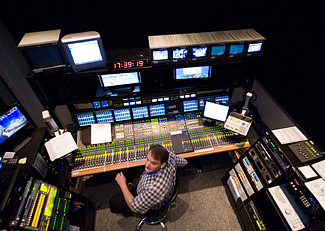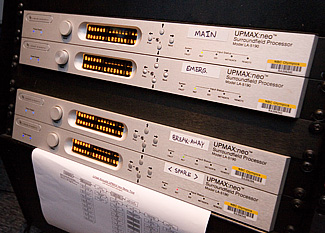NBC Serves All With 5.1, Stereo
BEIJING
Audio highlights of NBC's Beijing effort included the first true 5.1 digital surround sound from live network venues, a 16-channel embedded audio infrastructure, and up/down mixing between 5.1 and stereo as needed.
For the first time, NBC produced and distributed six discrete audio channels for its 5.1 programs as part of the embedded audio inside the HD-SDI signal. But, just as camera operators shot to protect the 4:3 image that the majority of home viewers saw, NBC also produced its audio in a world where most home viewers would be listening in stereo, but viewers who went the extra mile to set up a 5.1-capable home theatre expected more.
"This means that everything we do in China serves both communities," said Bob Dixon, NBC's director of sound design and communication at the Olympics, on the day of the closing ceremonies. "We are sending six discrete channels of audio with HD pictures to the U.S., but we are also paying great attention to the down-mix of those channels for our stereo audience."

The audio mixing room built around a Calrec mixing desk.A SOUND PORTRAIT
Any effort to capture the audio sense of place at an Olympic venue by necessity relies on the host broadcaster and BOB (Beijing Olympic Broadcasting) came through in Beijing, mixing all venues in 5.1.
"The host broadcaster did a very nice job with the 5.1 on the wide shot," said Dixon. Dixon said reliance on the host has been increasing as NBC takes fewer audio splits as they have in the past due to budget restraints.
That being said, 5.1 is really quite new to many. "On a global basis there's not a lot of 5.1 experience. … HD isn't everywhere and 5.1 is certainly not everywhere," said Dixon. He added that many staffers have learned a lot really only since the last Games. "The experience that our own engineers have had with 5.1, even in just the last two years, is really showing. … You can tell that they are much better at it, and they are more comfortable with multichannel sources than before."
Dixon said the goal was to have audio convey a sense of place. He related his experience on the final day of competition watching and listening to the finish of the mens' marathon in the IBC 5.1 "listening room."
"When the lead runner entered the stadium it was just beautiful," he said. "I thought I was in the stadium. The sense of crowd was very well transmitted."
For NBC the transition to 5.1 has been happening since Athens, where they were doing ProLogic. And the host has also been experimenting with 5.1 for a while, but now with HD and the ability to have discrete channels, "It's really let us develop this art more," said Dixon.
UPMIXING AND LOUDNESS
Although NBC offered all of its Olympic programming in HD with 5.1 sound, content recorded or edited through systems without enough channels for 5.1 was upmixed using Linear Acoustic UPMAX:neo units.

Linear Acoustic UPMAX:neo units "We learned a lot of things about upmixing, in working with Linear Acoustic, and having [Linear Acoustic President] Tim Carroll here in Beijing with us," said Dixon. "His interest in getting it to be more discrete has taught us things. … I'm quite happy with the upmixing of the two-channel material."
Dixon said NBC used Dolby LM100 loudness meters in Beijing and these helped NBC stay very consistent with the audio. "We have a target of –23 dB and reports from the States have said it's been remarkably consistent venue to venue," he said. "Our staff are watching that number and mixing to it. … Mixing to a loudness number is really nice because once you establish that then you bring your mix to wrap around that, it's been very helpful to us to keep ourselves consistent."
Some sports are more challenging than others in terms of loudness issues.
Dixon said that beach volleyball, for example, was a great sport for audio, but also a challenge.
"It's a very young sport with a great feel to it, the music, the crowd, every time a play is over they bang right into the music, and sometimes that hurt us a lot because it was much too loud," he said. "It can be hard to deal with that with open microphones, but they also want the live crowd to get into it of course."
The house mixers were Calrecs—located at the IBC and the athletics, gymnastics, aquatics and beach volleyball venues, the four largest venue operations for NBC. Mics include systems from Audio-Technica and Sennheiser.
NEXT TIME
Dixon said he was looking forward to the sounds of the upcoming 2010 Winter Games in Vancouver, where NBC will carry the audio progression over to the sounds of those events. "Winter sports have very different sounds than summer sports, scraping sounds of blades on ice or skis on snow," said Dixon. "When you're following somebody down a mountain and he's cutting into that snow as hard as he can or when you're listening to a speedskater just grabbing that ice with his blades, it's very dramatic."
What else might be coming? David Mazza, senior vice president for engineering at NBC Olympics, said that by Vancouver they might be close to tackling the audio editing in the EVS, on the Surround side, because the IP Edit (software) allows for eight channel dissolves. The issue may be a practical one rather than technical, however.
"Our editors barely have enough time to get the shows turned around as it is, let alone deal with the added complexity of editing in surround," said Mazza.
Although the industry is approaching the point where edit rooms can handle it, Mazza wonders if the edit staff has time to handle it.
"[And] unless the editors are all going to go to audio mixing school, it may be asking a lot of them to get the pictures right in a big hurry, and six channels of audio, plus a two channel down mix," he said. "That remains a big question for those of us who do fast turnaround editing in the field."
Get the TV Tech Newsletter
The professional video industry's #1 source for news, trends and product and tech information. Sign up below.

